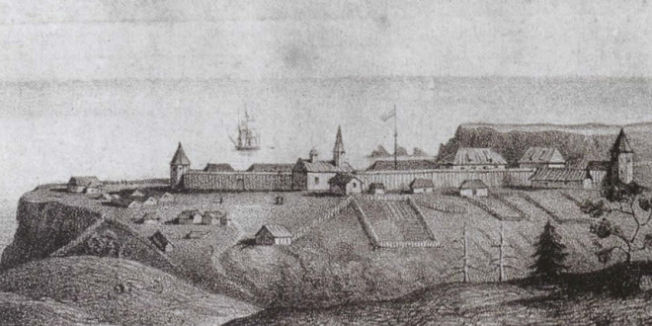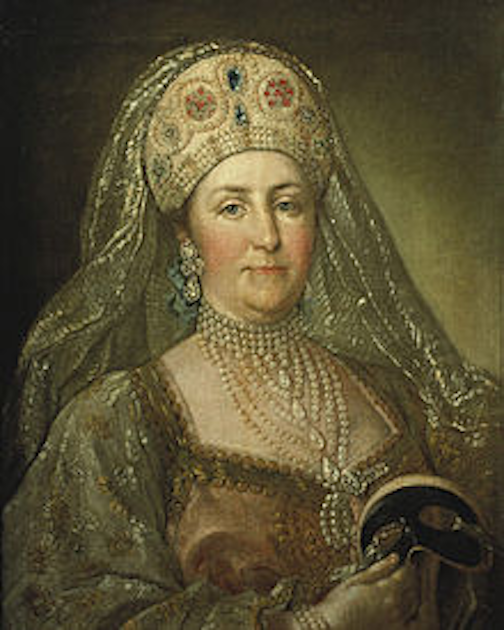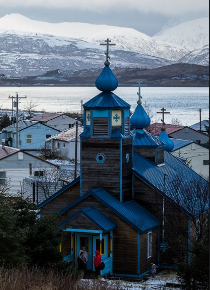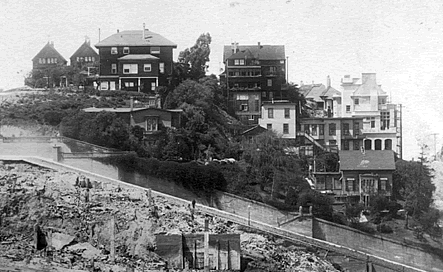
RUSSIAN FORT ROSS, CALIFORNIA DRAWING OF 1828 PERIOD — Similar to today
President Thomas Jefferson declared, “Russia as the Power friendliest to the Americans.” And clearly, the American Revolution expanded the positive relations between the two nations.

CATHERINE THE GREAT OF RUSSIA = A FRIEND TO AMERICANS
Russia played an important and supportive international diplomacy role on the American side for the Thirteen Colonies in the American Revolutionary War Against the Kingdom of Great Britain. This contributing a lasting positive legacy for the American Revolution abroad. Catherine the Great’s (1762–1796) greatest contribution was refusing to provide soldiers and naval power to the British during the War.
Catherine believed “that the separation of the colonies from the mother country did not conflict with the interests of Russia and might even be advantageous to her.” Catherine took a keen interest in the American struggle because it affected “English and European politics”, and she and Russia played a role in the American Revolutionary War through her politicking with other European heads of state, and blamed the British Royals for their greed in the conflict. She held a negative opinion of King George and his diplomats, often treating them with contempt. The British Royals asked Catherine for 20,000 troops in 1775 and she refused. With Spain’s entry into the war, and the British Royals again asked for help with naval support and again Catherine refused the request.
News of the Declaration of Independence’s penning and signing reached Russia on August 13, 1776. A Russian ambassador wrote great praise for the leadership, bravery, and virtue of colonial leaders as shown through the declaration and also admired the actions of the American forefathers.
Of almost equal importance in Catherine’s diplomatic contribution to America was the Proclamation of Armed Neutrality in 1780, after the war, that allowed “neutral ships” to freely visit and trade at ports of belligerent Powers and pass without hindrance, except for those carrying war materials. Most of Europe agreed but of course, the British refused to recognize the arrangement and tried to BLOCKADE AMERICA. Without that agreement American might have been STRANGLED BY THE BRITISH ROYALS AGAIN as was tried again in the War of 1812.
During the war, Catherine attempted to mediate between the United States and Britain with a ceasefire plan, but the Battle of Yorktown ended any hope of a peaceful and diplomatic solution to the American Revolutionary War. In 1780, while Catherine was working for peace, the British Royals attempted to bribe Russians with land to bring Russia onto British side, and again Catherine refused the British bribe and made George III a laughing–stock of the European powers. Catherine acted in the best interest of the American people and against the British and probably changed the course of the war in the Americans favor.
Russia and Catherine played a critical role of great international significance in the American Revolutionary War as a mediator and caused a vital “improvement of the international position of the rebelling colonists for (separation from) Great Britain, and, in the final analysis, for the victory of the young republic” with the Declaration of Armed Neutrality by Russia in 1780 which received the official approval of the Continental Congress of the United States in October, 1780. If Catherine had not brought other European nations into neutrality, then perhaps American history would be much different from what it is today. Catherine the Great attributed the British loss to the actions of former colonists and blamed the loss by the British Crown on its greedy policies imposed by the Royals.
Of course, Russia and Americans had many mutually beneficial relationships including Benjamin Franklin and the Russian Imperial Academy of Sciences, plus they shared prosperous commercial trade relationships with many merchants from both countries freely trading with each other after 1783.
The American victory undoubtedly weakened the British Royals and the American revolutionary ideas inspired Russian authors Alexander Radishchev and Nikolay Novikov to write about American successes during the war, but condemn slavery, and rebuke the decimation of Native Americans. The American Revolution even inspired some members of the 1825 Decembrist Revolt in St. Petersburg, but the Jewish takeover with the USSR did not occur until 1917.

Russians were used to a very hard existence in 1800s
Russian representatives to the United States reported that American civilians enjoyed the enumerated liberties as outlined by the declaration and constitution. The Declaration of Independence inspired the beliefs and doctrines of some members of Russia’s Decembrist Uprising. To them, America represented a sort of “motherland of freedom.” The Declaration of Independence infiltrate the minds of Russian society leading to the Decembrist Revolt.

Russian Orthodox Church at Old Harbor on Kodiak Island in 1897
PRE-REVOLUTION AND RUSSIAN DEVELOPMENT IN AMERICA: Russia looked to North America after reaching the Pacific Ocean in 1639 and occupying the Kamchatka Peninsula in the 1680s. From 1729–1741, Russia sponsored the Danish explorer Vitus Bering and his Russian counterpart Aleksei Chirikov to begin the Russian search for North America. In their initial 1729 expedition, the pair missed the Alaskan coast due to a thick fog. When they set off again in 1741, Chirikov reached the shore of the Alaskan panhandle only to have his search party ambushed and killed by the native Tlingits, so Chirikov hurriedly sailed back to Kamchatka. Vitus Bering, on the other hand, had worse luck. He made it ashore to central Alaska, and then sailed back to Kamchatka along the barren Aleutians, only to endure a hard winter on one of the islands, losing many men. However, when Bering and his remaining crew returned to Petropavlovsk, they brought with them over nine hundred sea otter pelts, an impressive prize in those early days that sparked greater interest in the fur trade and striking it rich.
During these early times, many natives were exploited and killed and many animals were hunted to near-extinction. In 1764, a valiant native resistance was finally defeated by Russians in 1766. Another such attack was in 1784 Awa’uq Refuge Rock Massacre of the Qik’rtarmiut Sugpiat tribe by 130 Russian armed fur traders and cannoneers who slaughtered around 2,000 native men, women and children in Alaska.
Prior to the onset of the American Revolutionary War, the Russian expansion into North America boosted the Russian economy and added prestige, but caused much detriment to the local wildlife of Alaska, and brought about the desolation of the Aleut through disease, warfare, and exploitation.
Russia established its first colony in Alaska in present day Anchorage and Sitka in 1804. In Alaska, Russia setup 23 trading posts with easy access to ports for the fur and fishing trades and 2,500 Russians lived in Alaska along with 8,000 indigenous people during those early days. Alaska offered access to growing Asian markets and served merchant ships plus offered valuable animals, fishing, and forests.

Russian Orthodox Church in Anchorage today
In late 1700s Russia carved out a slice of California giving it the coastal areas from current day Alaska, Western Canada, Washington, Oregon, and California down to 40 miles north of San Francisco.
In 1784 an adventurous fur merchant established the Three Saints Bay Colony, Russia’s first permanent North American settlement, on Kodiak Island in Alaska, as the first step towards converting the Pacific Ocean into Russia’s “Inland Sea.” In 1799 the powerful Russian-American Company was established and gained a monopoly over Alaskan fur trade and held on until Alaska was purchased by the U.S. in 1867.
Otter pelts were easily the area’s most profitable commodity, but after a few decades of over-hunting otters began to grow scarce and Russian settlers had difficulty growing farms in Alaska’s cold unforgiving terrain with a short growing season. Food was scarce much of the year, and frozen ports made supply the colonists difficult. So Russia set her sights on California. At first, the Alaskan colonies were after more food sources, but California’s abundance proved tantalizing. Soon Russians stake their own claim on its sunnier and still otter-rich coastline. In 1808 Russia expanding trading from Alaska and in 1812 Russia established ports and villages along the current Northern California Coast as far south as 40 miles north of present day San Francisco. This included establishing FORT ROSS with a shipping port & agricultural villages, which is now an interesting California State Park with the Fort shows harsh living conditions that terrifies most Americans of today. Russians in 1812 built Fort Ross just 60 miles north of present day San Francisco, and is still the largest lingering trace of Russian society held behind a wooden fortress. The land was acquired from the local Native Americans for “three blankets, three pairs of breeches, two axes, three hoes, and some beads.” Fort Ross housed Russian occupants for 29 years, but never solved Alaska’s food crisis and soon ran low on otter furs. In 1841, Fort Ross territory was sold to an American pioneer named John Sutter (1803-1880), for the agreed-upon sum of $30,000, which he never paid.
Click for Source Article on Russians in California
In 1821 Russian leader Alexander I controlled from Alaska down the coast of Canada & Washington & Oregon all the way to just 40 miles north of San Francisco. To maintain this Russian presence against Spanish conquest Alexander published an edict that prevented foreign vessels from coming within 100 miles of the Russian Northwest coastal ports. Soon US Secretary of State John Quincy Adams contested “the right of Russia to any territorial establishment on this continent, and said U.S.” assumed control of the American continent and were no longer subjects of any colonizing nations, Russia included. Just two years later, President James Monroe issued an American Edict against colonialists inhabiting America lands of Destiny with the creation of one of America’s most famous documents: the Monroe Doctrine.
San Francisco owes its existence to Russia’s North American presence when on October 28, 1776, as the Revolutionary War ragged in the east, San Francisco was established by the Spanish, to discourage Russia from moving further southward. San Francisco’s famous “Russian Hill” neighborhood shows how Russians had impacted the early settlement in the Bay Area and Russian Merchant tombstones provide another trace of the Russians on the North Coast.

Russian Hill in 1906 after Earthquake in San Francisco
In 1832 Russia and America formally signed a trade treaty that President Andrew Jackson said, “furnished new motives for that mutual friendship which both countries have so far nourished with respect to each other.”
In 1867 the Alaska Purchase by America from Russia was ratified by the United States Senate, and signed by president Andrew Johnson. This added a massive 586,412 square miles of land to America and was and has been wildly positive for Americans.
The Forgotten History of Russia’s California Colony Oct. 8th, 2016
div{float:left;margin-right:10px;}
div.wpmrec2x div.u > div:nth-child(3n){margin-right:0px;}
]]>
 RSS Feed
RSS Feed















 June 14th, 2017
June 14th, 2017  Awake Goy
Awake Goy  Posted in
Posted in  Tags:
Tags: 













